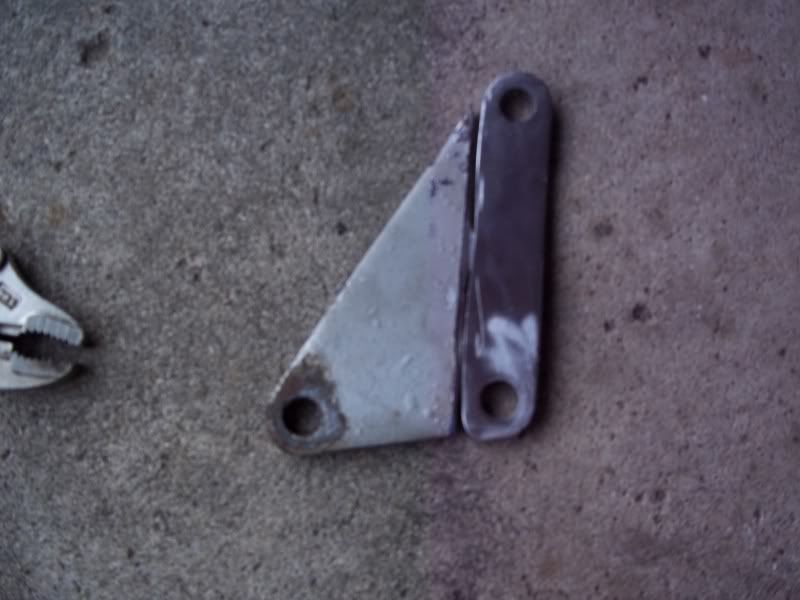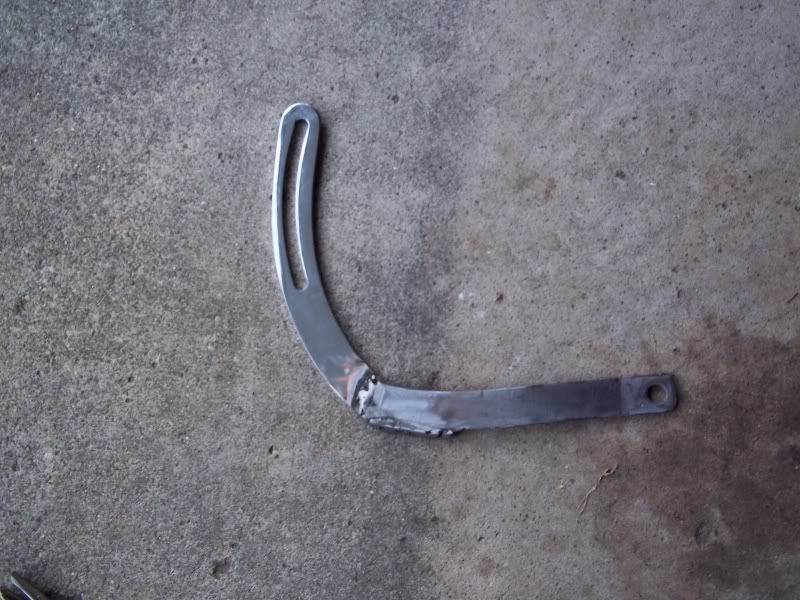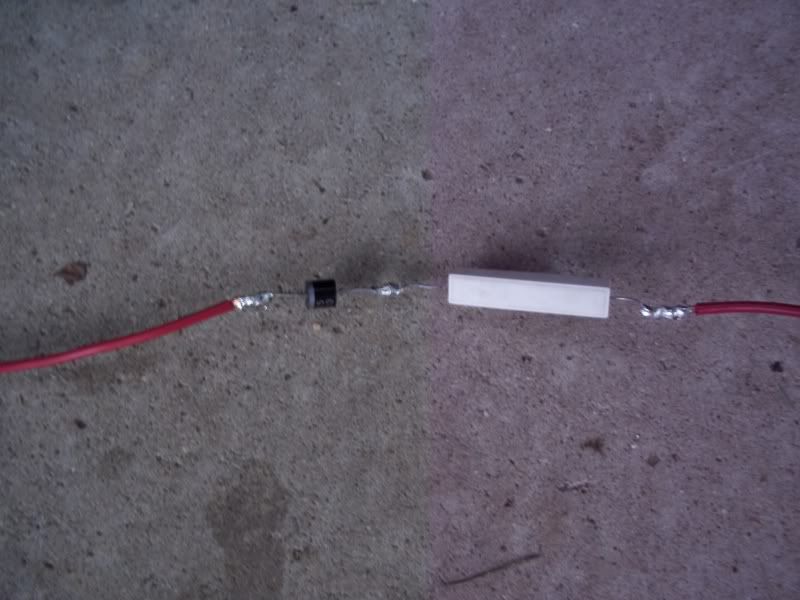How to: GM12SI alternator on a small block
I've had problems off and on with the original Chrysler dual field alternator and regulator. I've been through a few regulators, alternators, etc...I was also never too happy with the performance at or near idle. I was driving the car recently, the voltage regulator malfunctioned, and the voltage started fluctuating wildly (this was at night too), so I decided I wanted to go to a simpler, internally regulated alternator...and one that is easy to get if it broke later, not expensive, and also could fit on the car.
My car has Magnum heads so alternators are a tight fit to the head, as there is a boss that is very close to the back of the alternator.
I went down to advance auto parts and bought an alternator for a 1985 Pontiac Firebird 305. This will give you a 10si or 12si alternator with the "3 o'clock" clocking, which will put the BAT stud and cooling intake in the correct location outside the confines of the engine block. The regulator connector will face down. Interestingly enough, if you order a P7127-M3, listed for a 10SI, 63 amp application, they gave me a 78 amp 12si alternator, when they would normally charge $80+$16 core for this alternator, I could get it for $45 + $10 core. 10SI and 12SI delco alternators are the same physical size, so there is no difference. You can get a 12SI in up to 94 amps in a stock application, and it will look just like what you'll see here.
Also, you'll need to buy a few additional parts. You'll need to buy a universal GM alternator bracket (Mr Gasket makes the one I used for $10.99), a 50 ohm, 10w resistor, and a rectifier diode. The resistor and diode are available at Radio Shack under part numbers 271-133 and 276-1661 respectively. This will cost about $6, and you'll have extras.
So, for the brackets, you'll need to modify as follows:

Slice the stock brace as shown. You'll need to reverse the direction of the bend, as the mounting lugs on the delco alternator will stick out instead of be closer to the head like the stock setup. Its amazing that the offset from zero is the same, just in opposite directions. I used a cutoff wheel and flap disk to do this.

You'll need to slice a stock 70+ non-a/c bracket up (basically cut the slotted section off, and mock up the Mr Gasket chevrolet bracket, so you clear the alternator fan and have adjustability. Mine ended up looking like this (my welds aren't that great, I know). If you do an overlap style weld like this, it will line up right and be very strong. If it doesn't look perfect, don't worry, its hard to see once installed.

Next, you'll need to get the soldering Iron out. Hook the diode and resistor up as shown. The grey stripe on the diode will be on the end that will be hooked to the "1" terminal on the alternator. Hook the other end to a fused, keyed 12V source. I had a wire feeding my electric choke, so I tapped into that. This wire will allow the alternator to be excited so it will charge. I covered all of this with electrical tape...use that or heat shrink tubing. The diode keeps your engine from having "run on" which is caused by electricity backfeeding into your ignition with the key off, and the resistor simulates a "194" light bulb, which would normally be in the idiot light circuit on a Chevrolet of this era.
For the "2" terminal, you'll need to extend your blue wire from your old alternator field wires. This provides the sensing point on your dash harness. It will maintain this point (the splice for the ignition system feed) at 14.3-14.7V. Nothing special needs to be done here. Test this for high resistance and damage just to be thorough.
Connect your old "BAT" terminal to the "BAT" terminal on the new alternator. My car has 10 GA, and feeds power directly to the starter relay...you'll need to upgrade this if its stock, the stock wiring can't handle 78 amps. I am planning on putting bigger wire than 10ga in soon. I'd suggest removing the ammeter and using a volt meter. My car feeds the dash harness off of the starter relay. MAD Electrical has some ideas on this.
The finished product will look like this:


Now, should there be alternator failure, not only did I buy an alternator for $55 with an internal regulator and lifetime warranty, I can get one of these nearly anywhere. Most auto parts stores carry a 10SI or 12SI right on the shelf. The performance is excellent. Even at a 850rpm idle, there is almost no voltage change with the lights, radio, and wipers on.
I know not everyone will like this...some are purists, but this works great, and costs under $100.
I'd be happy to answer questions about this...and hear your thoughts.
I've had problems off and on with the original Chrysler dual field alternator and regulator. I've been through a few regulators, alternators, etc...I was also never too happy with the performance at or near idle. I was driving the car recently, the voltage regulator malfunctioned, and the voltage started fluctuating wildly (this was at night too), so I decided I wanted to go to a simpler, internally regulated alternator...and one that is easy to get if it broke later, not expensive, and also could fit on the car.
My car has Magnum heads so alternators are a tight fit to the head, as there is a boss that is very close to the back of the alternator.
I went down to advance auto parts and bought an alternator for a 1985 Pontiac Firebird 305. This will give you a 10si or 12si alternator with the "3 o'clock" clocking, which will put the BAT stud and cooling intake in the correct location outside the confines of the engine block. The regulator connector will face down. Interestingly enough, if you order a P7127-M3, listed for a 10SI, 63 amp application, they gave me a 78 amp 12si alternator, when they would normally charge $80+$16 core for this alternator, I could get it for $45 + $10 core. 10SI and 12SI delco alternators are the same physical size, so there is no difference. You can get a 12SI in up to 94 amps in a stock application, and it will look just like what you'll see here.
Also, you'll need to buy a few additional parts. You'll need to buy a universal GM alternator bracket (Mr Gasket makes the one I used for $10.99), a 50 ohm, 10w resistor, and a rectifier diode. The resistor and diode are available at Radio Shack under part numbers 271-133 and 276-1661 respectively. This will cost about $6, and you'll have extras.
So, for the brackets, you'll need to modify as follows:

Slice the stock brace as shown. You'll need to reverse the direction of the bend, as the mounting lugs on the delco alternator will stick out instead of be closer to the head like the stock setup. Its amazing that the offset from zero is the same, just in opposite directions. I used a cutoff wheel and flap disk to do this.

You'll need to slice a stock 70+ non-a/c bracket up (basically cut the slotted section off, and mock up the Mr Gasket chevrolet bracket, so you clear the alternator fan and have adjustability. Mine ended up looking like this (my welds aren't that great, I know). If you do an overlap style weld like this, it will line up right and be very strong. If it doesn't look perfect, don't worry, its hard to see once installed.

Next, you'll need to get the soldering Iron out. Hook the diode and resistor up as shown. The grey stripe on the diode will be on the end that will be hooked to the "1" terminal on the alternator. Hook the other end to a fused, keyed 12V source. I had a wire feeding my electric choke, so I tapped into that. This wire will allow the alternator to be excited so it will charge. I covered all of this with electrical tape...use that or heat shrink tubing. The diode keeps your engine from having "run on" which is caused by electricity backfeeding into your ignition with the key off, and the resistor simulates a "194" light bulb, which would normally be in the idiot light circuit on a Chevrolet of this era.
For the "2" terminal, you'll need to extend your blue wire from your old alternator field wires. This provides the sensing point on your dash harness. It will maintain this point (the splice for the ignition system feed) at 14.3-14.7V. Nothing special needs to be done here. Test this for high resistance and damage just to be thorough.
Connect your old "BAT" terminal to the "BAT" terminal on the new alternator. My car has 10 GA, and feeds power directly to the starter relay...you'll need to upgrade this if its stock, the stock wiring can't handle 78 amps. I am planning on putting bigger wire than 10ga in soon. I'd suggest removing the ammeter and using a volt meter. My car feeds the dash harness off of the starter relay. MAD Electrical has some ideas on this.
The finished product will look like this:


Now, should there be alternator failure, not only did I buy an alternator for $55 with an internal regulator and lifetime warranty, I can get one of these nearly anywhere. Most auto parts stores carry a 10SI or 12SI right on the shelf. The performance is excellent. Even at a 850rpm idle, there is almost no voltage change with the lights, radio, and wipers on.
I know not everyone will like this...some are purists, but this works great, and costs under $100.
I'd be happy to answer questions about this...and hear your thoughts.